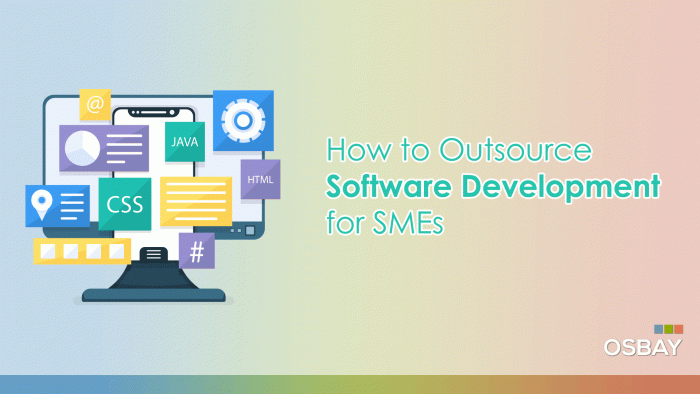For small and medium-sized enterprises (SMEs), staying competitive means leveraging smart technologies without burning through limited resources. One powerful strategy? Outsource software development. This approach empowers SMEs to access top-tier development talent, speed up project timelines, and reduce costs—if done right.
In this blog, we’ll walk you through how to outsource software development for SMEs, step by step. You’ll learn what to consider, common pitfalls to avoid, and how to find the perfect development partner.
Why SMEs Should Consider Outsourcing Software Development
SMEs often struggle with tight budgets, limited internal resources, and the need to innovate quickly. Outsourcing levels the playing field by giving them:
- Access to global talent without the overhead of full-time hires
- Faster time-to-market thanks to experienced development teams
- Reduced costs with better control over budgets
- Scalability for projects of different sizes
- Focus on core business functions while the tech side is handled externally
Understanding the Types of Outsourcing Models
Before jumping in, SMEs should understand the main outsourcing models:
- Onshore Outsourcing: Hiring developers in the same country.
2. Nearshore Outsourcing: Working with teams in neighboring or nearby countries.
3. Offshore Outsourcing: Partnering with teams from distant countries with lower labor costs.
Each model has pros and cons in terms of cost, communication, and time zones.
When Should an SME Outsource Software Development?
Timing is key. Consider outsourcing when:
- You lack in-house technical expertise
- You want to launch a product quickly
- You have a defined project with a clear scope
- You need specialized skills for a short-term project
- Your internal team is overloaded

Defining Your Software Project Scope
Before contacting vendors, define your project’s scope. This includes:
- Objectives and business goals
- Target users and market
- Core features and functionalities
- Technology preferences (if any)
- Budget and timeline
A clear scope prevents misunderstandings and keeps the project on track.
Choosing the Right Outsourcing Partner
When outsourcing software development for SMEs, choosing the right partner can make or break your project. Look for:
- Proven experience in similar projects or industries
- Transparent pricing models
- A strong portfolio and positive client testimonials
- Good communication skills and project management capabilities
- Technical proficiency in required tools and frameworks
Don’t skip the due diligence phase—interview multiple vendors and ask for references.
Vetting and Interviewing Developers
When you’ve shortlisted potential partners:
- Ask for sample work or a code test
- Conduct video interviews with key team members
- Evaluate their problem-solving approach
- Check their communication style and responsiveness
- Ensure they understand your business needs
Good developers don’t just code—they think strategically about your goals.
Creating a Solid Outsourcing Agreement
A formal agreement protects both parties. It should include:
- Detailed scope of work (SOW)
- Milestones and deadlines
- Pricing and payment terms
- Intellectual property rights
- Non-disclosure agreements (NDAs)
- Termination clauses
Legal clarity prevents future disputes.
Setting Expectations and Communication Guidelines
Strong communication = successful outsourcing. Early on, establish:
- Project management tools (e.g., Trello, Jira, Asana)
- Communication channels (Slack, Zoom, Email)
- Weekly check-ins or sprint reviews
- Time zone overlap hours
- Language preferences
Consistency builds trust and reduces friction.
Choosing Between Freelancers vs. Agencies
SMEs must decide whether to hire freelancers or partner with an agency:
- Freelancers are ideal for smaller, one-off tasks. They’re often cost-effective but may lack project management or continuity.
- Agencies provide a team with project managers, developers, and QA experts. They offer scalability and long-term support.
Choose based on your project’s size, complexity, and duration.
Managing Quality Control
Outsourcing doesn’t mean handing over control. Stay involved by:
- Reviewing code regularly
- Asking for demos and progress reports
- Using test environments for QA
- Getting user feedback before launch
- Maintaining version control and documentation
A proactive approach ensures high standards.
Calculating the True Cost of Outsourcing
While outsourcing saves money, it’s not just about hourly rates. Consider:
- Communication overhead
- Project management time
- Revisions and bug fixes
- Potential delays
- Time zone differences
A transparent cost-benefit analysis helps you plan smarter.
Protecting Intellectual Property
Outsource software development for SMEs with security in mind. Ensure:
- NDAs are signed
- Access to code and data is restricted
- Contracts include IP ownership clauses
- Partners comply with relevant data protection laws (e.g., GDPR)
Protecting your IP is non-negotiable.
Building a Long-Term Relationship
Successful outsourcing isn’t just about one project. Look for partners who:
- Understand your long-term goals
- Offer support and maintenance
- Provide suggestions for improvement
- Communicate openly and honestly
Treat it as a partnership, not a transaction.
How to Transition from In-House to Outsourced Teams
Smooth transitions reduce downtime. Steps include:
- Documenting processes and codebases
- Assigning a project manager to oversee handover
- Scheduling overlapping work periods
- Running onboarding sessions for the outsourced team
- Starting with a pilot project
Gradual handoffs work best.
Tools to Simplify Outsourcing
Make collaboration easier with tools like:
- Slack – Communication
- Jira – Project management
- GitHub/GitLab – Code repositories
- Zoom/Google Meet – Meetings
- Figma – Design collaboration
Using the right tools boosts transparency and productivity.
Common Mistakes to Avoid
- Outsourcing without a clear plan
- Focusing only on cost
- Skipping legal contracts
- Not testing early and often
- Ignoring time zone differences
- Micromanaging the outsourced team
Awareness prevents costly errors.

